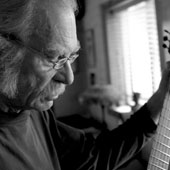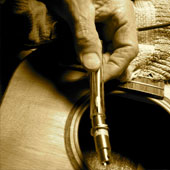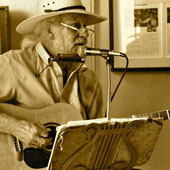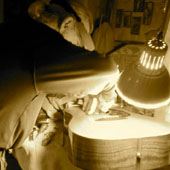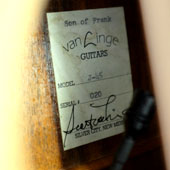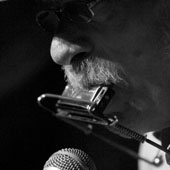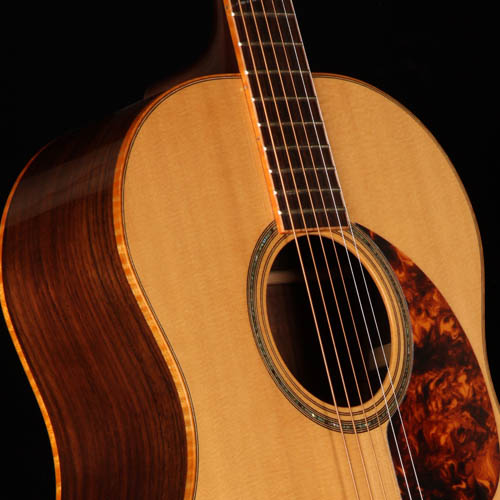Who is Scott van Linge?

How I Got Here
I never imagined I'd find myself building and hot-rodding guitars. I spent too many years in college during which a favorite escape was playing guitar and singing folk, country, blues and rock 'n' roll. It all started in l962 at a college party when I saw a guy/guitar with a combined three chord capacity encircled by four women. Three years later and that many major changes gave me a useful, if not brief look at engineering mechanics, and the manner in which forces and shape interact. Graduating from Stanford in June, l965, brought enough gift money to finally buy a used D-28, which I liked, but found somewhat disappointing. I finally summoned the courage to take my first paid ($3 for a half hour) guitar lesson in a Palo Alto music store from someone with the longest hair I'd ever seen. He straightened out my flat picking and showed me how he finger picked, holding a flat pick and opposing it with his ring finger. His middle finger was missing. He told me to listen to Doc Watson, and of a guitar store in Berkeley, where Jon Lundberg could shave the braces to bring out the sound. His band played Jon's modified Martins, but mostly had to play electric to make a living. On the wall was a promo b&w of the Warlocks, but Jerry said they were calling themselves the Grateful Dead. His teaching career soon ended. It would be five more years before I gave up academia, and discovered the joys of playing gigs for a living (along with a few pitfalls) and ten years before I finally visited Lundberg's with enough money to buy a '37 D-28. The story was it had been damaged in a car crash in the 50's and rebuilt with heavy braces. Jon said he had shaved them back to the way they were originally shaped in '37, and it sounded incredible. But he scalloped the X-brace too much, and the bridge pulled up so much its belly was coming unglued at the sides. I decided that was not too good an idea when I started to work on my original D-28 (a l960) in l983, when I had to sell the '37. But Jon did not scallop the belly braces (as they were on vintage Martins) instead, shaping them parabolically, the way he and Martin shaped the back braces. Since I had never even seen pictures of real vintage bracing, I headed off in a direction different from nearly all modern builders, who copy traditional scalloped bracing. Parabolically shaped braces, when balanced to just meet the forces exerted by the strings, no longer dampen the surface where they are glued. The gracefully curved shapes actually vibrate with the soundboard as they distribute energy from the bridge. The entire top and back (save for the neck area) are allowed to vibrate, and the instrument seems to come alive in your hands. Current thinking as to where sounds are created in a guitar is as follows: draw a line down the center of the top; because the high strings anchor to the right side of the bridge, the right side of the top makes the treble, and the left, the bass. It is my contention that each note reaches a resonance with a specific ring on the top, much as a drummer's cymbal has a specific pitch. Given uniform thicknesses, the smaller the cymbal's diameter, the higher the resonant pitch, and vice versa. A stereo speaker cone, as well as the cone of a Dobro, work in the same way, so why not a guitar top? In fact, it was my purchase of a Dobro in 1989 that ultimately led to this light bulb realization one night. I quickly unstrung the Dobro, removed the protective cover, and re-strung it so that I could feel the cone. Sure enough, the low D vibrated a ring at the outside edge of the cone, and each higher string resonated with a smaller and smaller ring.
Sound Is Round
I have had the unique opportunity of studying and modifying the insides of guitars made by all of the major manufactures, and over a dozen smaller builders including Collings, Huss and Dalton, Mossman, Musser, Goodall, McCollum, Griffin, Lucas, Leach, Sakashta, Thompson, Kinscherf, Pimentel and E.A. Foley. I have used the above model to analyze and correct balance problems on every guitar, including the ones I build. The basic idea is that when a brace that has too much mass for the job passes through a ring, it dampens an arc of that ring, reducing volume. The typical scalloped top on modern day Martins has ten peaks on its braces, created by the scalloped shaping. The dark spots on the braces show locations of the ten peaks. The two belly braces below the bridge look like the Golden Gate Bridge. Each peak creates an area on the soundboard (top) that can not vibrate much, a spot of about three square inches. You can actually find them by thumping lightly with the fleshy part of a finger, much as you can find studs in a wall. Multiply by ten, and you have a lot of underutilized prime soundboard. Streamlined parabolic braces (including the bridge) not only vibrate with the strings' energy, they have much less mass than conventional braces of all types. That means less mass to get moving with every note, less inertia to overcome for a quick response and more headroom. Less total brace mass also absorbs less energy, giving much greater sustain, more energy transferred to the soundboard. When braces are parabolically shaped and carefully reduced to just balance the forces acting on them, they no longer dampen the soundboard where they are glued, resulting in a major increase in volume. There are two short braces out to the side of each leg of the X brace, called finger, or side braces. Current Martin bracing has these shaped with peaks, as do many others, but vintage model side braces are parabolic, both in length and cross section, just the way I shape them. A 1912 Martin was also missing the peak at the far end of the lower belly brace, giving it a full bottom end for such a small box, because it would have been parked over the largest rings. The diagram above also shows how the side braces lie in the rings that the B and E strings reach resonance with, and can really kill the treble. Why the Martin Company has forgotten what they once knew remains a mystery to me. I have only seen one guitar, one of three Collingses sent for brace work, in which these braces were parabolically shaped, needing no further work. Most builders consider them unimportant. I have refined, distilled, and continue to learn knowledge and subtleties from new challenges my work brings, which I bring to you, both revoicing your guitar, or building one of my own for you. I have published two articles in 'American Lutherie', a quarterly publication of the Guild of American Luthiers (www.luth.org). The first, in issue #47, Fall, 1996, is one of five articles by luthiers dealing with brace shaving. You might notice that none of the other contributors give any specifics. The second, in issue #66, Summer, 2001, entitled 'A Bridge for the 21st Century', discusses the observations and work that led me to develop my own, very simple bridge design.

